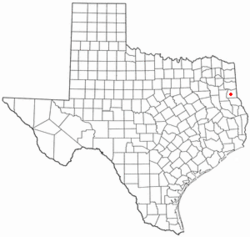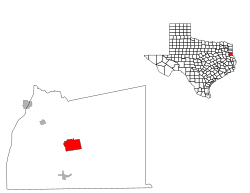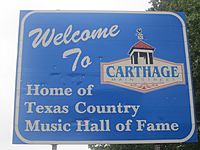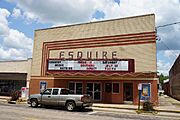Carthage, Texas facts for kids
Quick facts for kids
Carthage, Texas
|
|
|---|---|
| City of Carthage | |

The historic Hawthorn-Clabaugh-Patterson House is now used for offices of the Carthage Chamber of Commerce.
|
|
| Motto(s):
"Country at its best!"
|
|

Location of Carthage, Texas
|
|
 |
|
| Country | |
| State | |
| County | Panola |
| Area | |
| • Total | 10.68 sq mi (27.67 km2) |
| • Land | 10.66 sq mi (27.61 km2) |
| • Water | 0.02 sq mi (0.06 km2) |
| Elevation | 299 ft (91 m) |
| Population
(2020)
|
|
| • Total | 6,569 |
| • Density | 603.28/sq mi (232.92/km2) |
| Time zone | UTC-6 (Central (CST)) |
| • Summer (DST) | UTC-5 (CDT) |
| ZIP code |
75633
|
| Area code(s) | 903 |
| FIPS code | 48-13108 |
| GNIS feature ID | 2409400 |
Carthage is a city in and the county seat of Panola County, Texas, United States. The city is situated in deep East Texas, 20 miles west of the Louisiana state line. Its population was 6,569 at the 2020 census.
Contents
History
Carthage was founded in 1847, two years after Texas was admitted to the United States. During the Civil War, men from Carthage and Panola County served as Confederate soldiers. African-American resident Milton M. Holland, formerly enslaved, served as a Union sergeant and earned a Medal of Honor.
Carthage, Mississippi was established in 1834, and became the county seat. The Harris family were early settlers, and named the town after their former home of Carthage, Tennessee. When Carthage, Texas established in 1848, it was named after Carthage, Mississippi.
After the Civil War, population growth was slow, but large amounts of cotton, corn, sweet potatoes, oats, and sugarcane were produced in the county. The city began to expand in 1888 when a railroad reached Carthage, along with telegraph and telephone lines.
During the Great Depression, a gas field was discovered near Carthage. After World War II, this gas field was developed and proved to be the largest in the United States. The city flourished, with the population increasing from about 1,300 to 5,000. During this period, a courthouse and a high school were built. In 1947 Panola County Junior College was established in Carthage and founded KGAS-AM 1590 which began broadcasting in 1955.
As a result of 19.6% population growth between 1970 and 1980, documented by U.S. Decennial Census; Panola General Hospital was established in 1997. Today the ETMC Carthage operates a 24-hour emergency department which is designated a Level IV trauma center by the state of Texas.
On August 22, 1998 the Tex Ritter Museum in Carthage was the site for the grand opening of the Texas Country Music Hall of Fame, honoring those who have made outstanding contributions to country music and born in the state of Texas.
On September 16, 1998 KGAS-FM began broadcasting a country music format in Carthage, and was featured in "Bernie", the 2011 American biographical black comedy crime film directed by Richard Linklater.
Geography
According to the United States Census Bureau, Carthage has a total area of 10.5 square miles (27 km2), of which 10.5 square miles (27 km2) are land and 0.04 square miles (0.10 km2) (0.4%) is covered by water.
The climate in this area is characterized by hot, humid summers and generally mild to cool winters. According to the Köppen climate classification, Carthage has a humid subtropical climate, Cfa on climate maps.
| Climate data for Carthage, Texas (1991–2020 normals, extremes 1951–present) | |||||||||||||
|---|---|---|---|---|---|---|---|---|---|---|---|---|---|
| Month | Jan | Feb | Mar | Apr | May | Jun | Jul | Aug | Sep | Oct | Nov | Dec | Year |
| Record high °F (°C) | 84 (29) |
90 (32) |
92 (33) |
93 (34) |
98 (37) |
103 (39) |
106 (41) |
108 (42) |
109 (43) |
95 (35) |
88 (31) |
85 (29) |
109 (43) |
| Mean daily maximum °F (°C) | 56.8 (13.8) |
61.4 (16.3) |
68.8 (20.4) |
76.0 (24.4) |
82.8 (28.2) |
89.3 (31.8) |
92.4 (33.6) |
93.1 (33.9) |
87.4 (30.8) |
78.0 (25.6) |
66.6 (19.2) |
58.9 (14.9) |
76.0 (24.4) |
| Daily mean °F (°C) | 46.5 (8.1) |
50.4 (10.2) |
57.5 (14.2) |
64.7 (18.2) |
72.8 (22.7) |
79.8 (26.6) |
82.8 (28.2) |
82.8 (28.2) |
76.7 (24.8) |
66.3 (19.1) |
55.6 (13.1) |
48.5 (9.2) |
65.4 (18.6) |
| Mean daily minimum °F (°C) | 36.1 (2.3) |
39.5 (4.2) |
46.3 (7.9) |
53.5 (11.9) |
62.8 (17.1) |
70.3 (21.3) |
73.2 (22.9) |
72.5 (22.5) |
66.0 (18.9) |
54.5 (12.5) |
44.5 (6.9) |
38.2 (3.4) |
54.8 (12.7) |
| Record low °F (°C) | 5 (−15) |
4 (−16) |
18 (−8) |
28 (−2) |
39 (4) |
45 (7) |
55 (13) |
50 (10) |
38 (3) |
26 (−3) |
12 (−11) |
1 (−17) |
1 (−17) |
| Average precipitation inches (mm) | 4.66 (118) |
4.23 (107) |
4.92 (125) |
4.72 (120) |
4.35 (110) |
4.04 (103) |
3.64 (92) |
3.44 (87) |
3.67 (93) |
4.54 (115) |
4.44 (113) |
5.63 (143) |
52.28 (1,328) |
| Average snowfall inches (cm) | 0.3 (0.76) |
0.4 (1.0) |
0.1 (0.25) |
0.0 (0.0) |
0.0 (0.0) |
0.0 (0.0) |
0.0 (0.0) |
0.0 (0.0) |
0.0 (0.0) |
0.0 (0.0) |
0.0 (0.0) |
0.0 (0.0) |
0.8 (2.0) |
| Average precipitation days (≥ 0.01 in) | 8.5 | 8.3 | 8.3 | 6.3 | 7.4 | 7.5 | 5.4 | 5.7 | 5.8 | 6.0 | 7.3 | 8.9 | 85.4 |
| Average snowy days (≥ 0.1 in) | 0.2 | 0.1 | 0.1 | 0.0 | 0.0 | 0.0 | 0.0 | 0.0 | 0.0 | 0.0 | 0.0 | 0.0 | 0.4 |
| Source: NOAA | |||||||||||||
Demographics
| Historical population | |||
|---|---|---|---|
| Census | Pop. | %± | |
| 1880 | 290 | — | |
| 1890 | 554 | 91.0% | |
| 1920 | 1,366 | — | |
| 1930 | 1,651 | 20.9% | |
| 1940 | 2,178 | 31.9% | |
| 1950 | 4,750 | 118.1% | |
| 1960 | 5,262 | 10.8% | |
| 1970 | 5,392 | 2.5% | |
| 1980 | 6,447 | 19.6% | |
| 1990 | 6,496 | 0.8% | |
| 2000 | 6,664 | 2.6% | |
| 2010 | 6,779 | 1.7% | |
| 2020 | 6,569 | −3.1% | |
| U.S. Decennial Census | |||
| Race | Number | Percentage |
|---|---|---|
| White (NH) | 3,990 | 60.74% |
| Black or African American (NH) | 1,271 | 19.35% |
| Native American or Alaska Native (NH) | 22 | 0.33% |
| Asian (NH) | 57 | 0.87% |
| Pacific Islander (NH) | 2 | 0.03% |
| Some Other Race (NH) | 9 | 0.14% |
| Mixed/Multi-Racial (NH) | 208 | 3.17% |
| Hispanic or Latino | 1,010 | 15.38% |
| Total | 6,569 |
As of the 2020 United States census, there were 6,569 people, 2,550 households, and 1,739 families residing in the city.
As of the census of 2010, 6,779 people, 2,628 households, and 1,745 families resided in the city. The population density was 645.6 people per mi2 (249.2/km2). The 2,909 housing units averaged 277.0 per mi2 (106.9/km2). The racial makeup of the city was 69.5% White, 21.1% African American, 0.5% Native American, 0.7% Asian, 6.5% from other races, and 1.7% from two or more races. Hispanics or Latinos of any race were 11.0% of the population.
Of the 2,628 households, 29.8% had children under the age of 18 living with them, 45.6% were married couples living together, 16.4% had a female householder with no husband present, and 33.6% were not families. About 30.5% of all households were made up of individuals, and 14.8% had someone living alone who was 65 years of age or older. The average household size was 2.45 and the average family size was 3.04.
In the city, the age distribution was 24.6% under 18, 11.2% from 18 to 24, 23.9% from 25 to 44, 24.1% from 45 to 64, and 16.3% who were 65 or older. The median age was 35.9 years. For every 100 females, there were 88.3 males. For every 100 females age 18 and over, there were 83.8 males.
As of the 2000 Census, the median income for a household in the city was $31,822, and for a family was $37,031. Males had a median income of $33,080 versus $21,473 for females. The per capita income for the city was $16,332. About 11.8% of families and 13.2% of the population were below the poverty line, including 15.2% of those under age 18 and 12.9% of those age 65 or over.
Culture and arts
The Texas Country Music Hall of Fame is located in Carthage, which also houses the Tex Ritter Museum. The Jim Reeves Memorial is located on the outskirts of Carthage, east on U.S. 79. Reeves and Ritter were from the nearby unincorporated communities of Galloway and Murvaul, respectively.
Education
The City of Carthage is entirely within the Carthage Independent School District.
The city also has the two-year community college of Panola College located adjacent Carthage City Hall.
All of Panola County is in the service area of Panola College.
Media
Carthage is served by two local radio stations: KGAS 1590 AM and KGAS 104.3 FM, and by a local newspaper, The Panola Watchman. The nearest media market of notable size is in nearby Shreveport, Louisiana.
Notable people
- John Booty is an American former football defensive back in the National Football League
- Jacke Davis was an American professional baseball outfielder
- Milton M. Holland was born the son of a slave owner but became the first native Texan to be awarded the Medal of Honor
- Philip Humber is an American former professional baseball
- Mildred Fay Jefferson was the first American black woman to graduate from Harvard Medical School;
- Derek Wayne Johnson is an American film director and 3rd Level Black Belt in the art of American Karate
- Margie Neal was a newspaper publisher and first American woman elected to Texas State Senate in 1926
- Jim Reeves was an American country and popular music singer-songwriter known as "Gentleman Jim"
- Brandon Rhyder is an American Texas Country/Red Dirt singer
- Tex Ritter was an American actor from the mid 1930s into the 1960s and a pioneer of American country music
- Jack Boynton Strong was an American politician and lawyer who served in the Texas Senate between 1963 and 1971
- Bernie Tiede is formerly a mortician convicted of murdering widow Marjorie Nugent
Image gallery
-
The Esquire Theater in Carthage hosts Country music on Saturday evenings.
See also
 In Spanish: Carthage (Texas) para niños
In Spanish: Carthage (Texas) para niños






